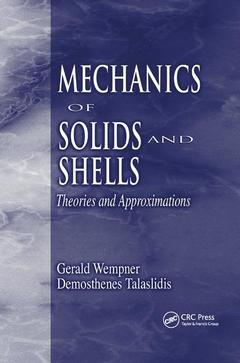Description
Mechanics of Solids and Shells
Theories and Approximations
Mechanical and Aerospace Engineering Series
Authors: Wempner Gerald, Talaslidis Demosthenes
Language: English
Subjects for Mechanics of Solids and Shells:
77.28 €
In Print (Delivery period: 14 days).
Add to cartPublication date: 09-2019
· 15.6x23.4 cm · Paperback
262.97 €
Subject to availability at the publisher.
Add to cartPublication date: 10-2002
530 p. · 15.6x23.4 cm · Hardback
Description
/li>Contents
/li>Readership
/li>Biography
/li>
As the theories and methods have evolved over the years, the mechanics of solid bodies has become unduly fragmented. Most books focus on specific aspects, such as the theories of elasticity or plasticity, the theories of shells, or the mechanics of materials. While a narrow focus serves immediate purposes, much is achieved by establishing the common foundations and providing a unified perspective of the discipline as a whole.
Mechanics of Solids and Shells accomplishes these objectives. By emphasizing the underlying assumptions and the approximations that lead to the mathematical formulations, it offers a practical, unified presentation of the foundations of the mechanics of solids, the behavior of deformable bodies and thin shells, and the properties of finite elements. The initial chapters present the fundamental kinematics, dynamics, energetics, and behavior of materials that build the foundation for all of the subsequent developments. These are presented in full generality without the usual restrictions on the deformation. The general principles of work and energy form the basis for the consistent theories of shells and the approximations by finite elements. The final chapter views the latter as a means of approximation and builds a bridge between the mechanics of the continuum and the discrete assembly.
Expressly written for engineers, Mechanics of Solids and Shells forms a reliable source for the tools of analysis and approximation. Its constructive presentation clearly reveals the origins, assumptions, and limitations of the methods described and provides a firm, practical basis for the use of those methods.




